Flowers are significant symbols of occasions and feelings in addition to being aesthetically pleasing. Have you ever wondered what kinds of flowers that start with C?
These flowers make a wonderful accent to any garden, wedding, or special occasion, ranging from delicate and exotic to common and hardy.
Exploring these flowers will inspire and enchant everyone, whether they are ardent gardeners, florists, or just admirers of nature’s beauty.
So let’s get started and learn about some of the most beautiful and intriguing flowers that start with C, as well as why you should give them a particular place in your heart and garden!
Keep Reading:
- Flowers That Start With A
- Flowers That Start With B
- Flowers That Start With D
- Flowers That Start With E
- Flowers That Start With F
List Of Flowers That Start With C
1. Cyclamen
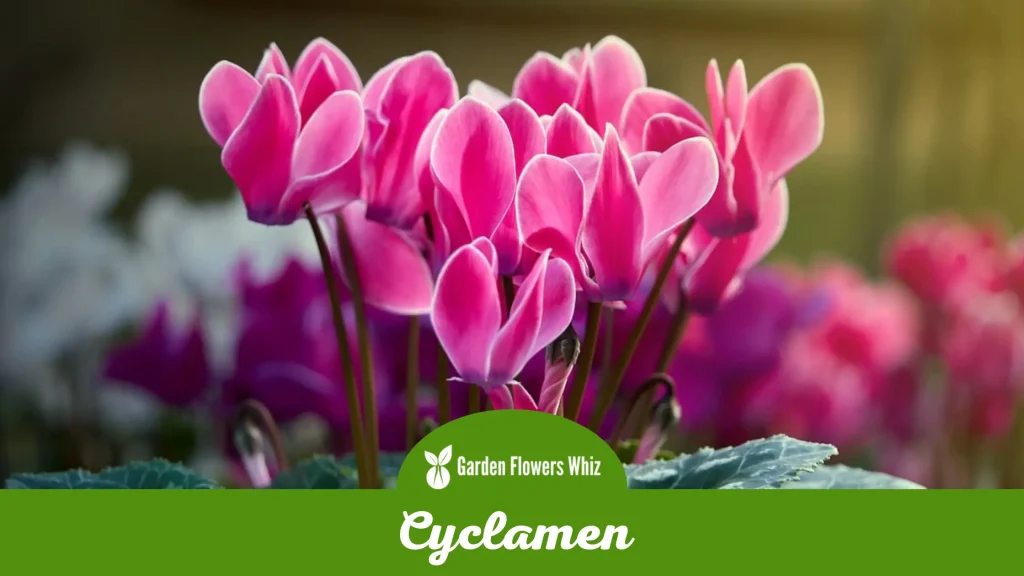
Cyclamen is a genus of blooming plants that is indigenous to the Mediterranean region, which includes sections of Europe, Asia, and North Africa. It is often referred to as sowbread.
It is a common ornamental plant that is cultivated for its lovely, long-lasting flowers, which come in a variety of colors from white to pink, red, and purple.
The blooms are characterized by their unusual form, five reflexed petals, and five conspicuous stamens. They are also frequently fragrant. Cyclamen is a perennial plant with heart-shaped leaves that have characteristic silver patterns that arise from a tuberous root.
Considering that it normally blooms in the winter and early spring, it is a well-liked option for both indoor and outdoor décor throughout the colder months.
Both chilly, shady conditions and well-draining soil are necessary for cyclamen. It is frequently planted in pots or other containers, and it can be multiplied by sowing seeds or dividing the tuberous root.
While being a lovely and resilient plant, cyclamen can be harmful if consumed by humans or animals. So, it is recommended to keep it out of children’s and animals’ reach.
2. Cuckoo Flower
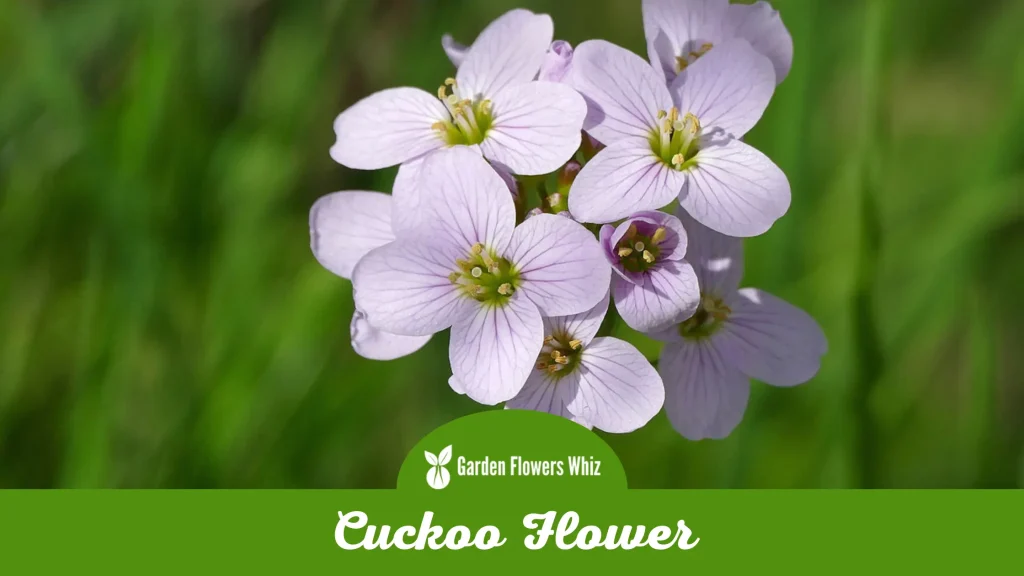
The herbaceous plant known as the cuckoo flower, also referred to as the lady’s smock is indigenous to Europe, Asia, and North Africa. It belongs to the brassica family and has four petals arranged in a cross configuration on its tiny, fragile flowers, which are often pale pink or white.
The flowers typically grow in bunches and smell like sweet honey. The cuckoo flower often blooms in the first several weeks of spring, making it a crucial source of nectar for bees and butterflies that fly early.
The orange-tip butterfly, whose larvae eat the leaves, uses it as a food source as well. Folklore links the cuckoo flower to the coming of spring and the cuckoo bird’s return, which is said to sing when the blossoms are in bloom.
The cuckoo flower frequently grows in meadows, along riverbanks, and in wet woodlands because it favors moist, marshy surroundings.
Because it is a hardy plant, it may be planted in gardens and other outdoor areas where it adds a delicate and lovely touch too early spring displays.
3. Crown Imperial

The striking Crown Imperial plant usually referred to as Fritillaria imperialis, is a native of the Middle East and Central Asia. It belongs to the lily family and grows a tall, erect stem that can reach a height of up to one meter, with a crown of sizable, bell-shaped flowers at the top.
The flowers are usually orange, crimson, or yellow, and they have a tuft of what looks like leaves on top. Popular decorative plants like Crown Imperial are grown for their dazzling displays.
It is frequently planted in gardens and other outdoor areas since it prefers well-draining soil and a sunny, protected setting. During the long winter, it is a lovely sight when it blossoms in the early spring.
Use caution when handling the plant because it contains alkaloids that are dangerous if consumed. Crown imperial is a gorgeous plant that gives any garden or floral arrangement a regal feel.
It truly stands out among spring-blooming flowers thanks to its imposing height and striking hues.
4. Crocus
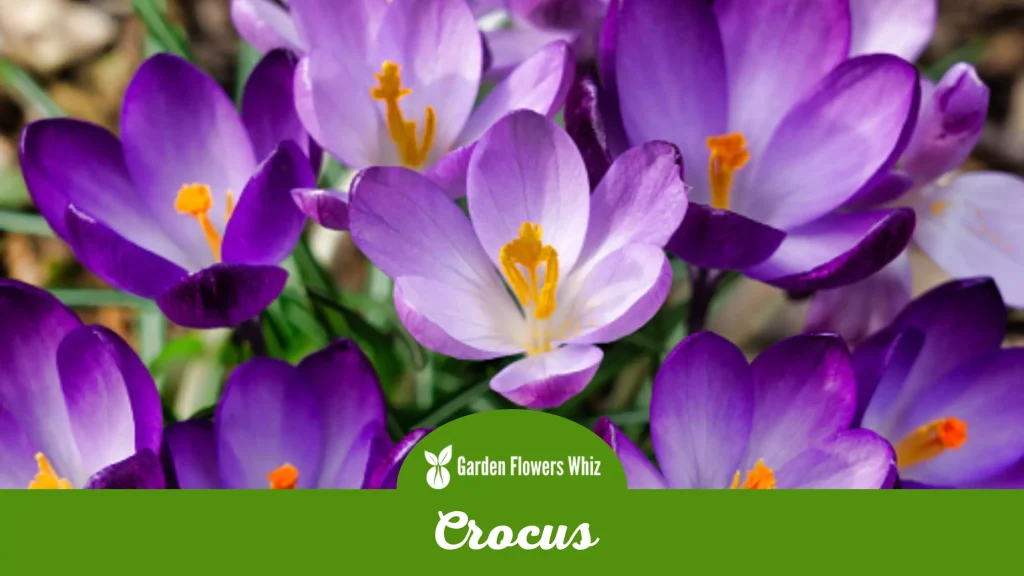
The iris family, Iridaceae, includes the tiny, bulbous perennial crocus, which is indigenous to the Mediterranean and Asia. It is a well-liked ornamental plant that is planted for its colorful, showy blossoms, which can be any color from white to purple to blue.
Crocus flowers are encircled by slender, grass-like leaves and contain three inner and three outer petals.
One of the first flowers to blossom after winter is the crocus, which blooms in late winter or early spring. It is a resilient plant that thrives in sunny conditions and well-drained soil, and it is frequently cultivated in gardens, parks, and other outdoor areas.
For flowering the following spring, crocus bulbs can be planted in the fall and are generally available. Moreover, they are frequently forced into pots or other indoor display containers.
Crocus is a bright and cheery addition to any garden or flower arrangement, and their early emergence heralds the start of spring.
5. Crocosmia
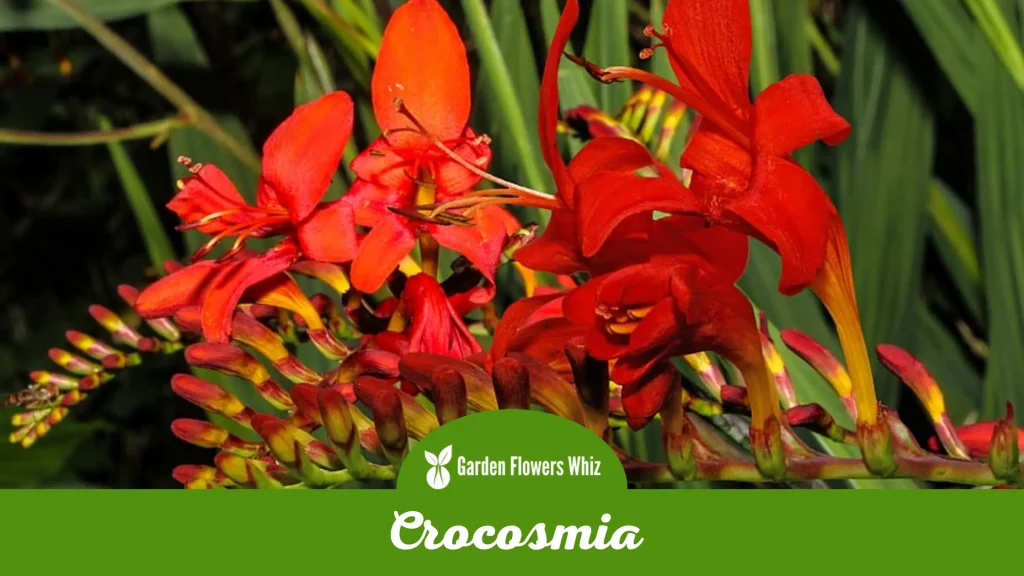
Crocosmia, commonly referred to as montbretia, is a genus of flowering plants that are indigenous to southern and eastern Africa and belong to the iris family, Iridaceae.
It is a common ornamental plant that is cultivated for its colorful, showy blossoms, which can be anywhere from yellow to orange to red and pink.
The flowers are carried on long, arching stems and have six petals arranged in a funnel form. Crocosmia is a well-liked option for bringing color and excitement to late-season gardens and floral displays because it blooms throughout the middle to late summer.
It grows well in gardens, borders, and containers and is a hardy plant that enjoys full sun and well-drained soil. For healthy, blooming plants, divide and transplant crocosmia bulbs every few years.
A lively and colorful plant, crocosmia brings a splash of color to any garden or floral arrangement. It is a favorite among gardeners due to its lengthy flowering season and hardiness.
6. Creeping Phlox

Native to North America, creeping phlox, commonly referred to as moss phlox, is a low-growing, spreading plant. It belongs to the phlox family and has tiny, delicate flowers that come in pink, purple, blue, and white hues.
Five-petalled flowers are grouped together at the stem terminals. Early-season gardens and rockeries frequently use creeping phlox to add color and interest because of its early spring blooming period.
This resilient plant is frequently cultivated as a ground cover or in rock gardens since it prefers full light and well-drained soil. For luring pollinators like bees and butterflies to the yard, creeping phlox is a superb option.
It is the perfect plant to use as a ground cover, border plant, or in rock gardens due to its hardiness and low growth habit.
7. Cranesbill Geranium
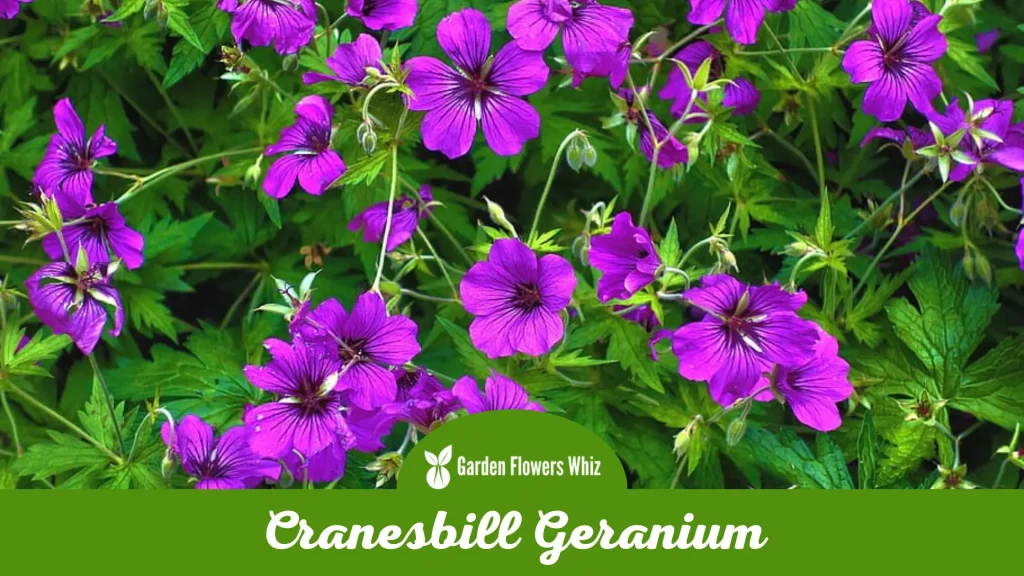
A genus of flowering plants in the family Geraniaceae that is indigenous to Europe, North America, and Asia is the cranesbill geranium, often known as the hardy geranium.
It is cultivated for its lovely foliage and delicate flowers, which come in a variety of colors from white and pink to blue and purple. It is a well-liked decorative plant.
The five-petalled flowers are borne in bunches at the stem terminals. The cranesbill geranium is a well-liked plant for bringing color and interest to the garden all through the growing season because it blooms in the early to mid-summer and continues to do so through the fall.
It is a hardy plant that grows well in borders, rock gardens, and as ground cover. It prefers full sun to moderate shade and well-drained soil.
It is a favorite among gardeners due to its hardiness and lengthy flowering season.
8. Cotoneaster

In the Rosaceae family of plants, the genus Cotoneaster contains woody plants that are indigenous to Asia, Europe, and North Africa. It is a well-liked ornamental plant that is cultivated for its lovely foliage and delicate flowers, which are followed by vibrant berries in red, orange, and black hues.
The five-petalled flowers are borne in bunches at the stem terminals. Cotoneaster is a well-liked option for bringing color and interest to the garden throughout the growing season because it blooms in the spring and early summer, and the berries ripen in the late summer and fall.
It is a hardy plant that does well in well-drained soil, full sun, or light shade and is frequently cultivated as a shrub, hedge, or ground cover.
Since cotoneaster has a deep root system that aids in stabilizing soil on incline surfaces like hillsides and steep slopes, it is used for erosion prevention in addition to its decorative appeal.
Birds rely on the plant as a major source of food since they eat berries throughout the winter. Gardeners and landscapers alike love it for its hardiness and versatility in growing environments.
9. Cosmos
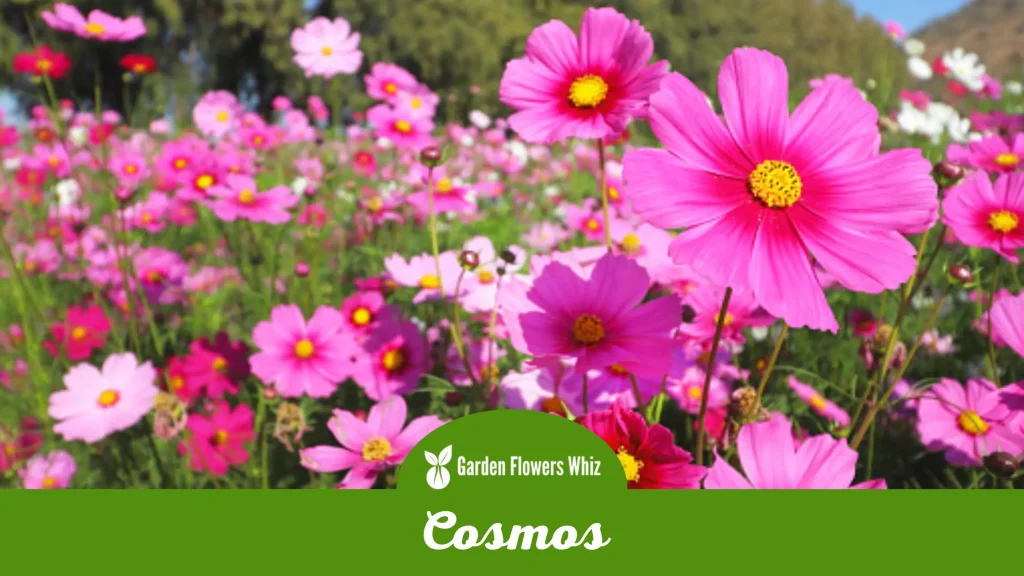
In the Asteraceae family, the genus Cosmos contains both annual and perennial flowering plants that are indigenous to Central and South America.
It is a well-liked ornamental plant that is planted for its lovely foliage and big, spectacular flowers that come in pink, purple, red, white, and yellow hues.
The blooms have an unusual open structure with petals that stretch outwards, surrounding a core disc. Because the cosmos blooms in the middle of summer and keeps blooming into the fall, it is a well-liked option for bringing color and interest to the garden all through the growing season.
It is a tough plant that does best in full sun and soil that drains well, and it is frequently planted in borders, pots, and for use as cut flowers.
10. Coreopsis
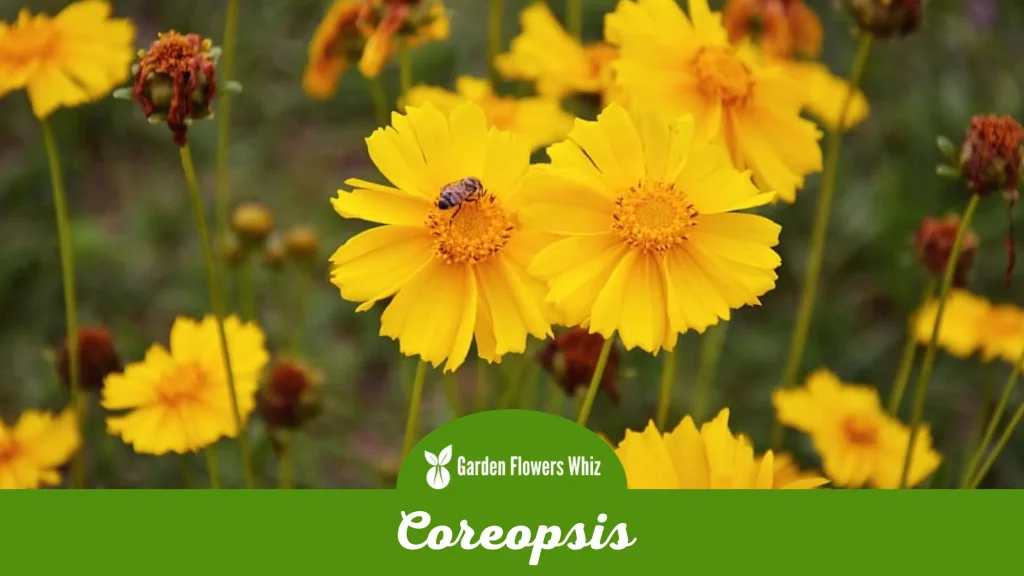
In the Asteraceae family of flowering plants, the genus Coreopsis sometimes referred to as tickseed, is indigenous to North America. It is cultivated for its lovely foliage and brilliant, daisy-like flowers, which come in hues of yellow, pink, red, and orange.
It is a well-known ornamental plant. The petals of the blooms fan outward from a central disc, giving them a characteristic form.
11. Coral Bells
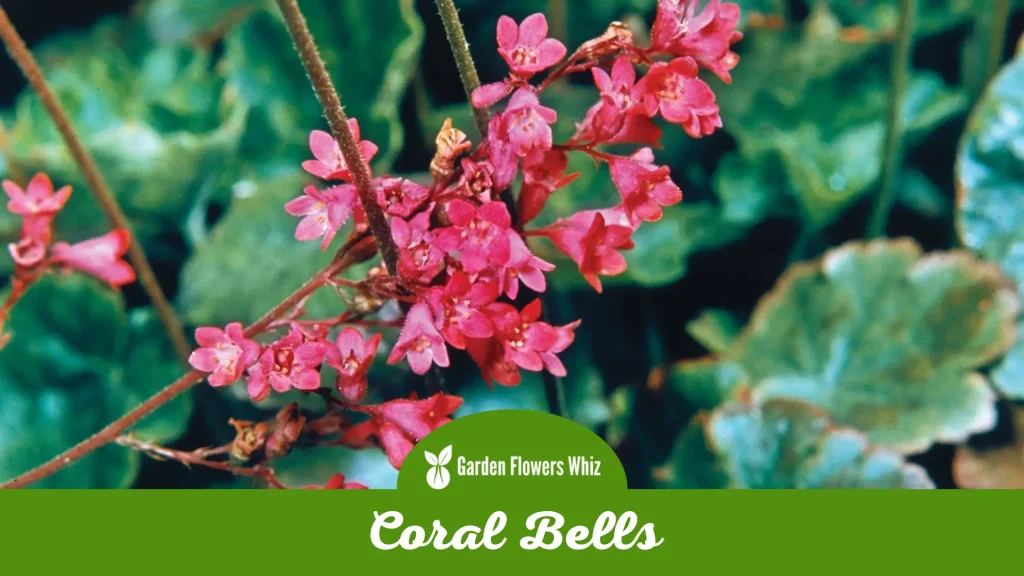
Heuchera, popularly known as coral bells, is a genus of herbaceous perennial flowering plants native to North America that belongs to the Saxifragaceae family.
It is cultivated for its lovely foliage and delicate blooms, which come in pink, red, white, and green hues. It is a well-known ornamental plant.
The flowers are carried on thin stalks above the foliage and have a characteristic bell form. Coral bells begin to bloom in the middle of the summer and continue until the fall.
It is a tough plant that does best in partial shade and well-drained soil and is frequently cultivated in rock gardens, ground covers, and border plantings.
Coral bells are not only beautiful, but they also serve as a significant source of honey for bees and other pollinators.
Gardeners love it because of its hardiness, lengthy blooming season, and low maintenance needs.
12. Coneflower
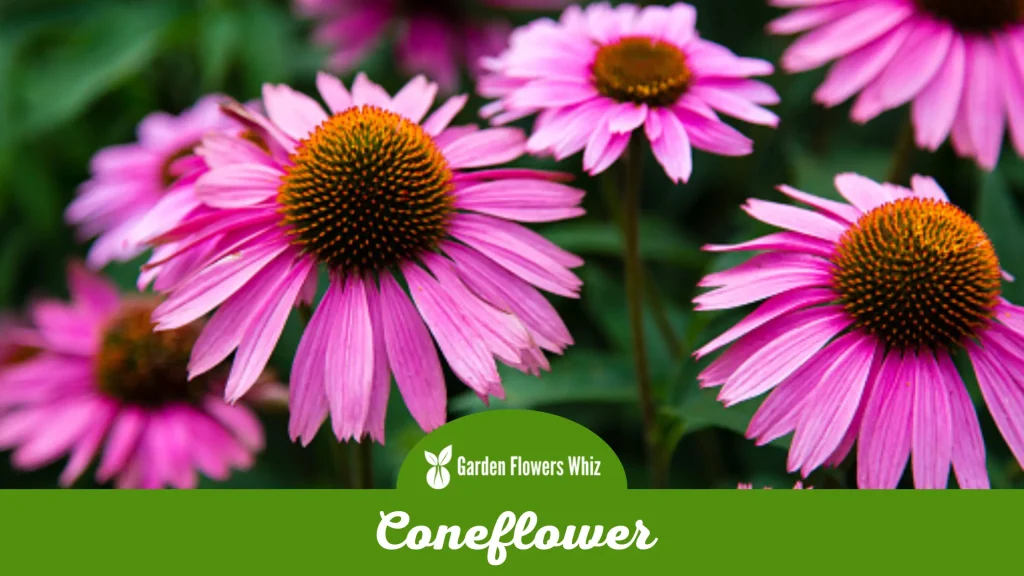
Echinacea, commonly referred to as coneflower, is a genus of herbaceous perennial flowering plants native to North America that belongs to the Asteraceae family.
It is a well-liked ornamental plant that is planted for its lovely flowers, which come in pink, purple, white, and yellow hues. The petals of the blooms fan outward from a central disc, giving them a characteristic cone form.
Coneflower is a well-liked option for bringing color and interest to the garden all through the growing season because it blooms in the middle of summer and keeps blooming into the fall.
It is a hardy plant that does best in full sun and soil that drains well, and it is frequently cultivated in borders, prairies, and for cut flowers.
13 Columbine
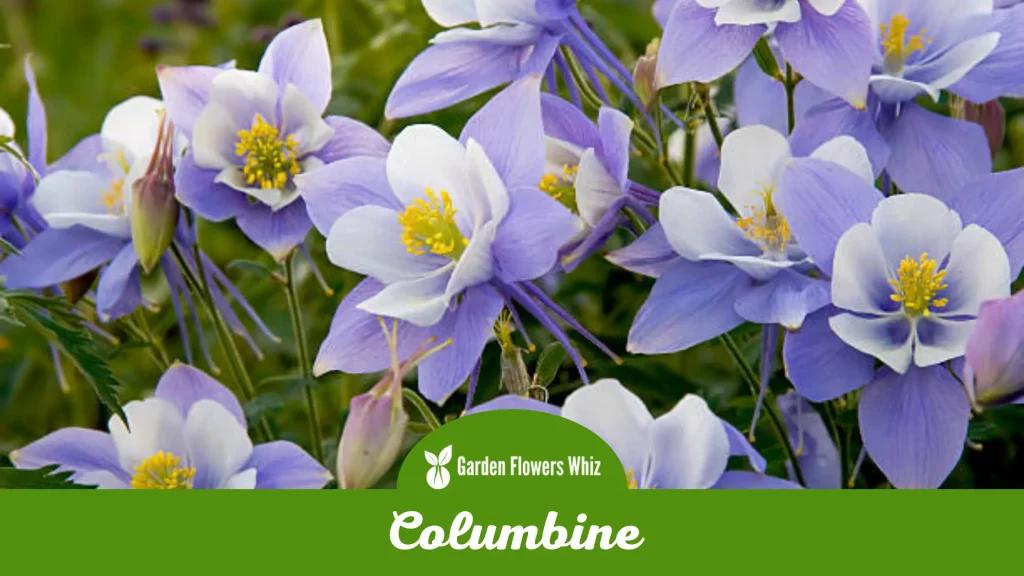
A genus of perennial blooming plants in the Ranunculaceae family with native ranges in North America, Europe, and Asia is known as columbine, sometimes known as aquilegia.
It is a well-liked ornamental plant that is cultivated for its delicate and lovely flowers, which come in pink, purple, blue, yellow, and white hues.
With five petals and five sepals that stretch backward, the flowers have a characteristic bell shape and resemble a bird in flight.
Columbine is a well-liked option for bringing color and interest to the garden as the seasons change from spring to summer because it blooms in late spring and early summer.
It is a tough plant that favors moist, well-drained soil and partial shade. It is frequently planted in borders, rock gardens, and as cut flowers.
Columbine serves as a significant source of nectar for hummingbirds and other pollinators in addition to its aesthetic value.
Gardeners prefer it because of its hardiness, distinctive blossoms, and low maintenance needs.
14. Cockscomb
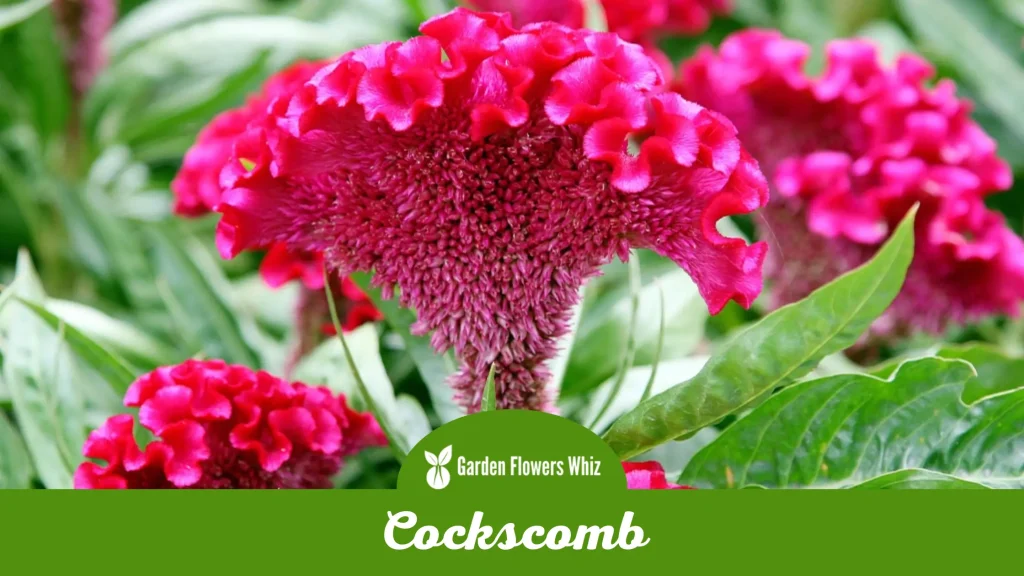
The annual flowering plant species cockscomb, also known as Celosia cristata, is a member of the Amaranthaceae family and is indigenous to tropical parts of Africa, Asia, and South America.
It is a well-liked ornamental plant that is planted for its colorful, showy blossoms that resemble a brain or a rooster’s comb.
Cockscomb is a well-liked option for bringing color and interest to the garden as the seasons change from summer to fall because it blooms in late summer and early fall.
It is a tough plant that does best in full sun and soil that drains well, and it is frequently planted in beds, borders, and as cut flowers.
15. Clover

Trifolium, another name for clover, is a genus of herbaceous flowering plants of the Fabaceae family that are indigenous to numerous parts of the world.
It is a well-liked plant for grazing and feed and represents luck and abundance. Mid-spring and early summer are when clover blossoms, giving out tiny, delicate flowers with pink, purple, and white hues.
The plant’s Latin name, Trifolium, which means “three-leaved,” comes from the way the blooms are often clustered in clusters of three.
Clover is significant for ecology and soil health in addition to its agricultural and symbolic importance. It is a crucial component of crop rotation and soil conservation measures due to its capacity to fix nitrogen from the atmosphere and transfer it to the soil.
The humble and helpful plant clover is essential to agriculture, the environment, and culture. It is a favorite of farmers, gardeners, and flower lovers alike due to its delicate beauty, low maintenance needs, and ecological advantages.
16. Clematis
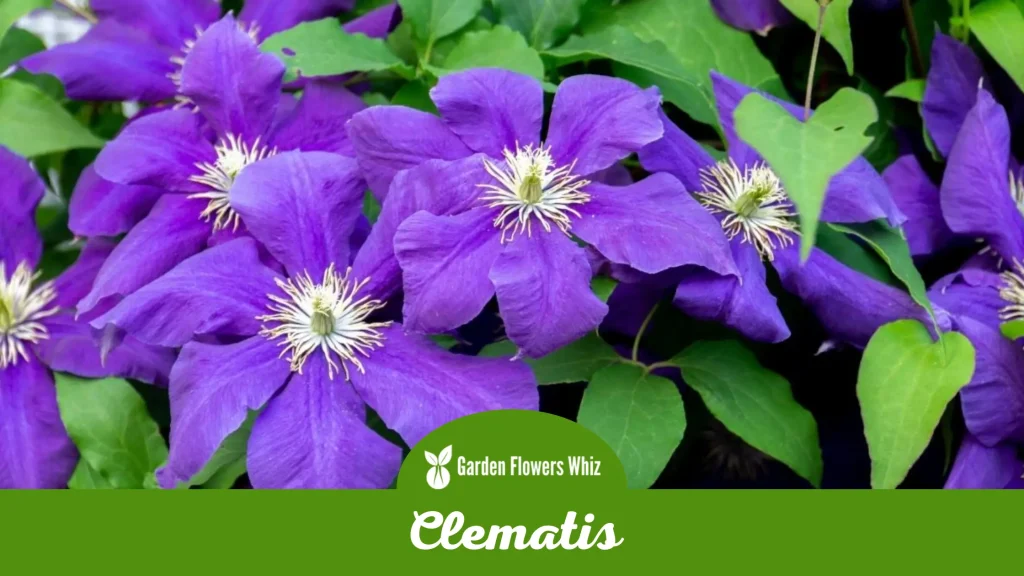
The Ranunculaceae family contains the genus Clematis, which includes climbing shrubs and vines that are indigenous to North America, Europe, and Asia.
It is a well-liked ornamental plant that is planted for its colorful flowers, which can be white, pink, red, purple, or blue. The blossoms are spectacular and frequently fragrant.
Late spring and summer are when clematis blooms, giving off a profusion of huge, eye-catching blossoms that can be either little and delicate or large and showy.
The blooms can have single or multiple petals and are often fashioned like stars or bells. Clematis is a popular choice for adding vertical flair to the garden or landscape since it is a hardy, adaptable plant that can be trained to climb trellises, fences, walls, and other structures.
It is frequently planted in borders, containers, and as cut flowers and enjoys full sun to light shade and well-drained soil.
It is a favorite among gardeners due to its hardiness, distinctive blossoms, and capacity for climbing.
17. Clarkia
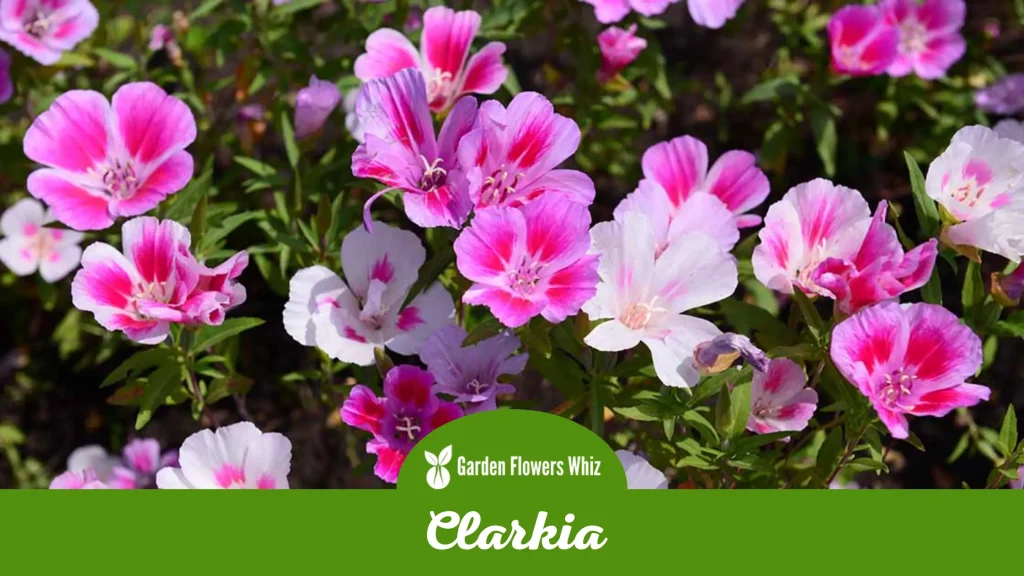
In the Onagraceae family, the genus Clarkia contains both annual and perennial plants that are indigenous to western North America. It is a well-liked garden plant that is planted for its vivid and showy flowers, which come in pink, red, purple, and white hues.
Late spring and early summer are when Clarkia blooms, giving up small, fragrant flowers that are often funnel- or cup-shaped and may have one or two petals.
The flowers are ideal for cut flower arrangements since they are produced on long, slender stalks that stand above the foliage. Hardy and simple to grow, Claudio prefers well-drained soil, full sun to partial shade, and both.
It is a favorite of pollinators like bees and butterflies and is frequently cultivated in borders, pots, and wildflower gardens. Any fan of flowers must have it because of its delicate blossoms, hardiness, and appeal to pollinators.
18. Chrysanthemum

Mums are a genus of perennial plants in the Asteraceae family that are native to Asia and northeastern Europe and are also referred to as chrysanthemums.
It’s a common garden plant that’s planted for its colorful, long-lasting flowers, which come in a range of hues like white, yellow, pink, red, and purple.
Throughout late summer and early fall, chrysanthemums blossom, giving up enormous, colorful flowers that can be either little and delicate or large and magnificent.
The blooms can have one or two petals and are frequently daisy- or pompom-shaped. Chrysanthemums are tough, adaptable plants that may thrive in a range of climatic conditions and soil types.
They grow nicely in borders, containers, and cut flowers and prefer full sun to partial shade and well-drained soil.
Chrysanthemums have a long cultural and historical tradition, and they are frequently connected to celebration, honor, and enduring beauty.
19. Celosia

Native to tropical parts of Africa, Asia, and South America, Celosia is a genus of annual and perennial plants of the Amaranthaceae family.
It is a common garden plant that is planted for its unusual and vibrant flowers, which come in pink, red, orange, yellow, and purple hues.
Celosia blooms in the summer and fall, giving birth to long-lasting flowers that can have one or many spikes and come in shapes ranging from brain-like to plume-like.
A touch of exotic elegance is added to any garden by the blossoms, which are frequently vibrantly coloured and velvety in texture.
Hardy and simple to grow, celosia enjoys full sun to partial shade and well-drained soil. It is frequently grown as cut flowers, in containers, and in borders.
Celosia has a long cultural history and is frequently linked to virtues like love, bravery, and wisdom.
20. Caucasian Stonecrop
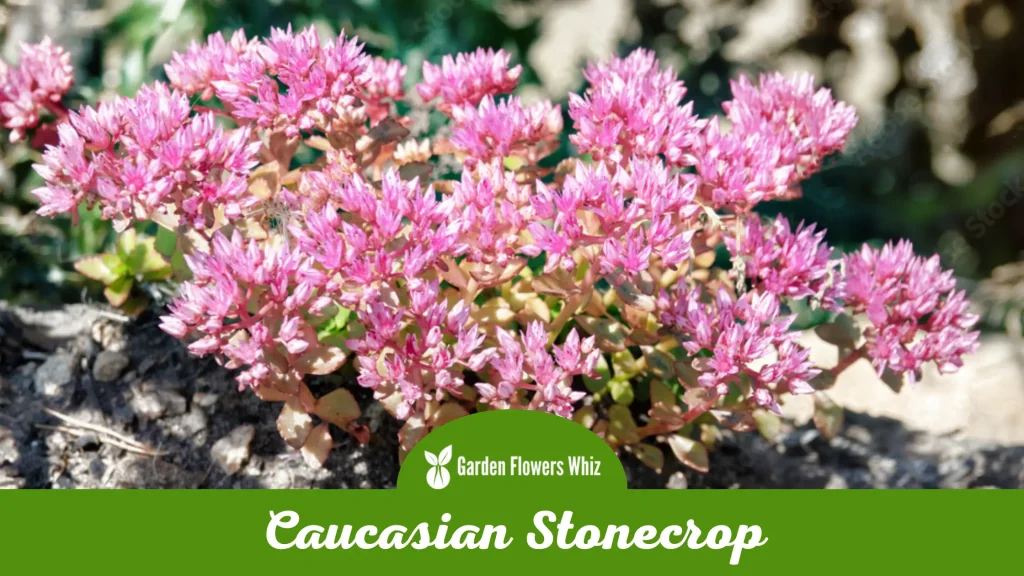
Sedum spurium, often known as Caucasian Stonecrop, is a perennial plant with a modest growth rate that is indigenous to Europe and Asia. It’s a well-liked garden plant that’s planted for its lovely foliage and late summer and fall flowering clusters of pink or red flowers.
Hardy and simple to grow, Caucasian Stonecrop enjoys full sun to light shade and well-drained soil. It is frequently cultivated as ground cover, in borders, and in rock gardens. It is a plant that can endure dry and arid environments and is also drought-tolerant.
Caucasian Stonecrop has juicy, meaty leaves that frequently turn scarlet in the fall. The tiny, star-shaped blossoms are capable of luring pollinators like bees and butterflies.
It is a well-liked option for both gardeners and landscapers due to its toughness and capacity to flourish in difficult situations.
21. Catnip
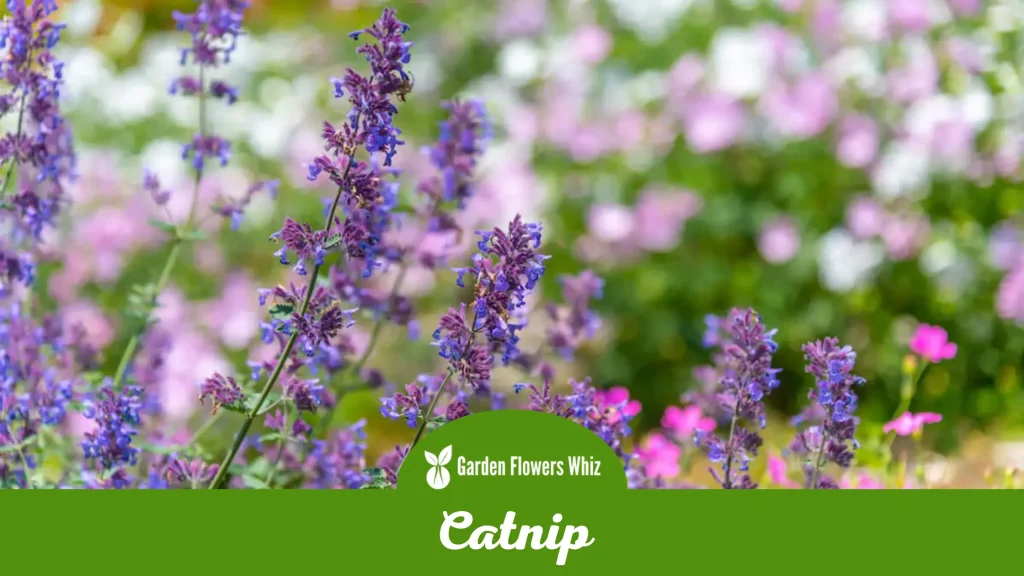
Nepeta cataria, usually referred to as catnip, is a herbaceous perennial plant that is indigenous to Europe and Asia. It belongs to the mint family and is renowned for having fragrant leaves and blossoms, much like other mints.
Catnip is a common garden plant that is grown for its lovely foliage and because cats love it. Catnip leaves are heart-shaped and gray-green in hue.
The blooms bloom in late spring and early summer and are tiny and white or lavender in colour. Catnip is frequently cultivated in herb gardens, and the leaves are used to create tinctures, flavoured teas, and essential oils.
Due to their attraction to its potent aroma, cats are known to respond favourably to catnip. Nepetalactone, the main ingredient in catnip, has been shown to have a variety of effects on cats, including hyperactivity, rolling, and drooling.
Both gardeners and pet owners favour it because of its cultural value and impact on cats.
22. Catchfly
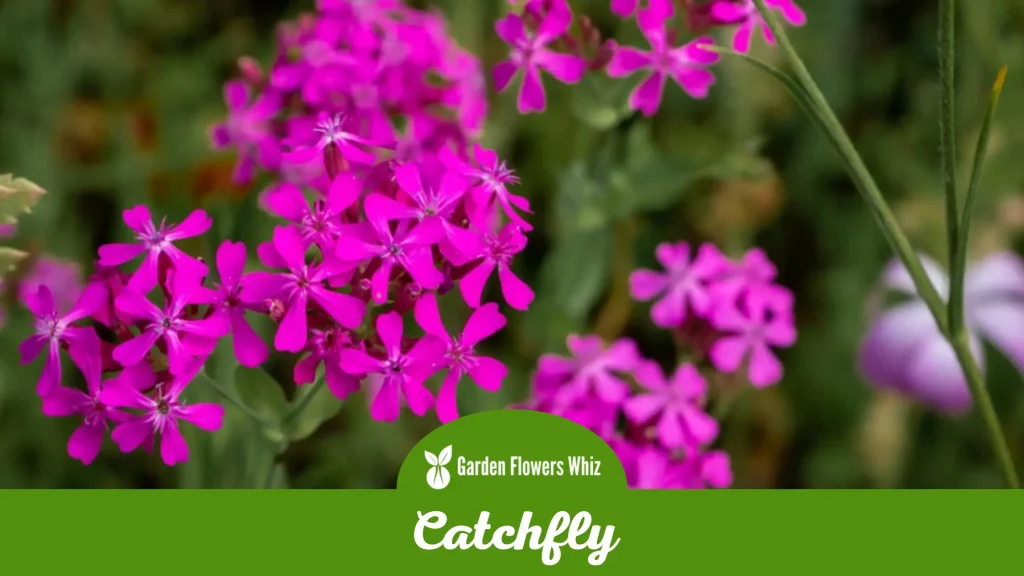
Silene armeria, or catchfly, is an annual blooming plant that is indigenous to Europe and Asia. It belongs to the family of carnations and is distinguished by its stunning pink petals and sticky stems.
The stems of the Catchfly can reach a height of two feet, and the leaves are slender and lance-shaped. At the top of the stalks, the pink, tiny flowers are clustered in clusters.
The term “catchfly” comes from a sticky material that coats the stems of catchflies and can trap small insects. Popular garden plants like catchflies are frequently planted in borders, rock gardens, and as cut flowers.
It favors well-drained soil and full sun over partial shade. Catchfly is utilized frequently in wildflower mixes since it is simple to grow and keep. Gardeners like it because of its interesting cultural importance and sticky stems.
23. Carolina Allspice
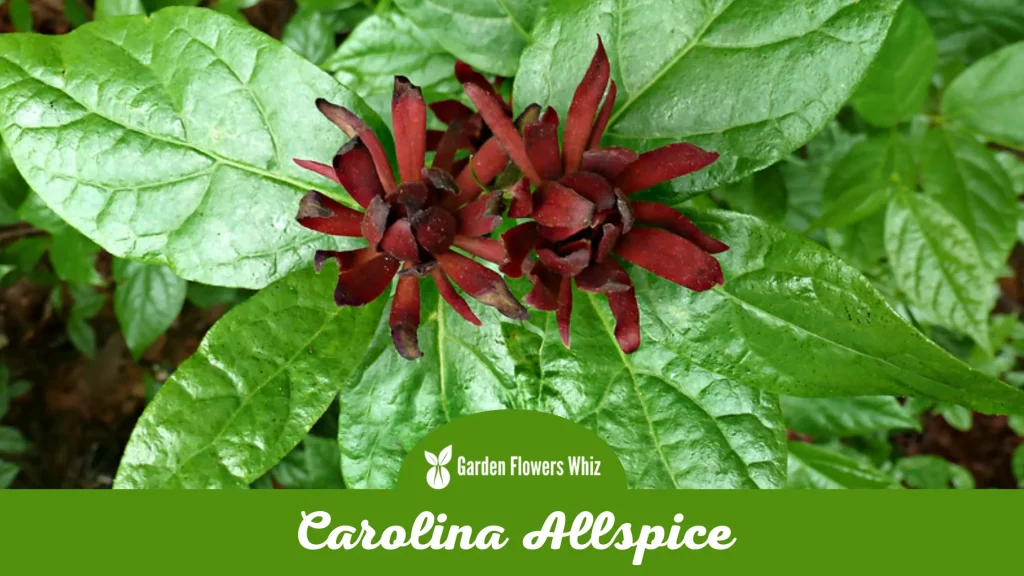
The southeastern United States is home to the deciduous shrub known as Carolina allspice or Calycanthus floridus. The reddish-brown, fragrant blooms that bloom in late spring and early summer are what are famous about it.
Carolina Allspice has glossy, dark green leaves and can reach heights and widths of 6 to 9 feet. While they are tiny, the flowers are produced in groups at the terminals of the stems.
They frequently appear in potpourri and perfumes because of their distinctive, spicy scent. Carolina allspice is a well-liked landscape plant that is frequently used as a specimen plant, in borders, and in hedges.
It favors well-drained soil and partial shade over the full sun. Carolina allspice is relatively resistant to pests and diseases and is simple to cultivate and maintain.
24. Carnation
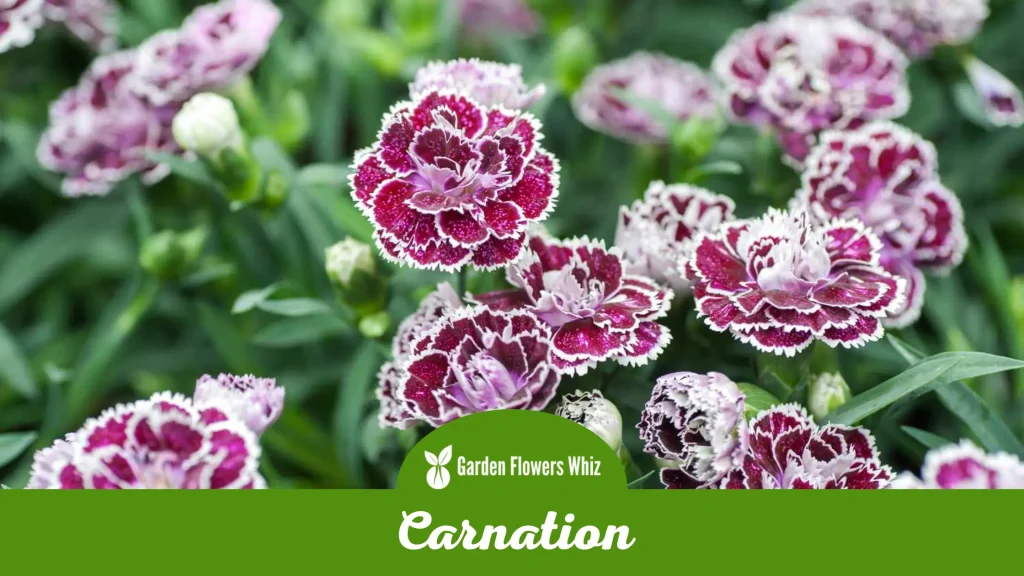
Dianthus caryophyllus, popularly known as the carnation, is a well-liked flowering plant that is indigenous to the Mediterranean area. It belongs to the family of carnations and is renowned for its spectacular, fragrant flowers that come in a variety of hues, including red, pink, white, and yellow.
Up to 24 inches tall, carnations are biennial or perennial plants. Their huge, beautiful flowers, which are frequently used in bouquets and floral arrangements, have slender, lance-shaped leaves.
Because they last a long time in vases, carnations are also widely used in the cut flower market. Carnations are frequently used as ground cover, borders, and rock gardens since they are reasonably simple to produce and manage.
They favour well-drained soil and full sun over partial shade. Moreover, carnations are largely resistant to pests and diseases.
Carnations have a long history of cultivation and cultural significance. They are a common flower for weddings, Mother’s Day, and other special occasions since they are frequently connected with love and affection.
25. Carmine Cob
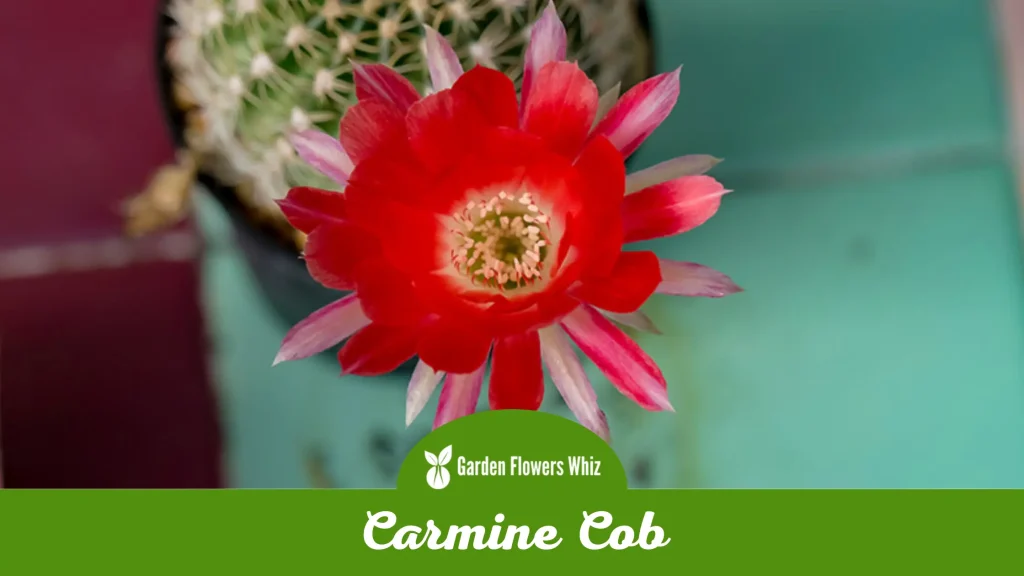
26. Cardinal Flower

The stunning perennial plant known as the Cardinal Flower is a native of North America with the scientific name Lobelia cardinalis. Its vivid red, tube-shaped blossoms, which resemble the robes worn by Catholic cardinals, are the source of the plant’s name.
The tall, upright stems, which can go up to 4 feet tall, are covered in clusters of flowers. Since it thrives in moist soil, the cardinal flower is frequently seen growing in wetlands, among streams, and in other soggy areas.
Hummingbirds love it as well since they are drawn to the vibrant red blossoms.
27. Cape Primrose
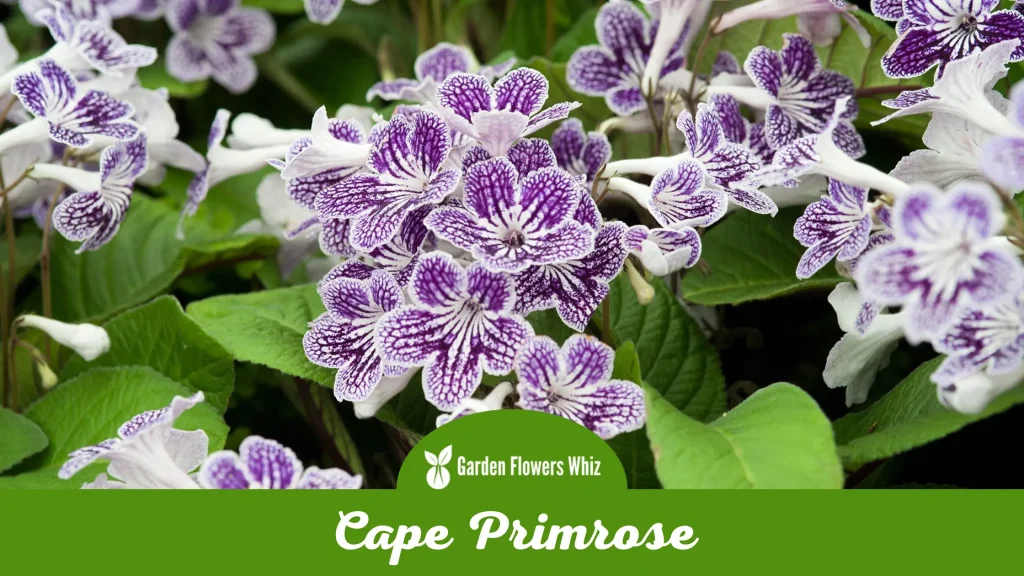
Streptocarpus, the scientific name for the Cape Primrose, is a well-liked indoor plant with a magnificent display of vibrant and delicate flowers.
This plant is a Gesneriaceae member and is indigenous to tropical Africa. Long and slender, typically dark green and velvety to the touch, the leaves of the Cape Primrose.
Its blossoms are available in a variety of hues, including as pink, purple, blue, white, and yellow. Each bloom is bell-shaped and appears to have five ruffled petals.
Cape Primroses prefer bright, indirect light and well-drained soil. They should be watered on a regular basis, but it’s important to avoid overwatering because this might make the plant rot.
Due to their low maintenance requirements and gorgeous blooms, Cape Primroses are a popular choice for indoor gardening. In hot, humid areas, they can add a lot to outdoor gardens that are shaded.
28. Cape Daisy
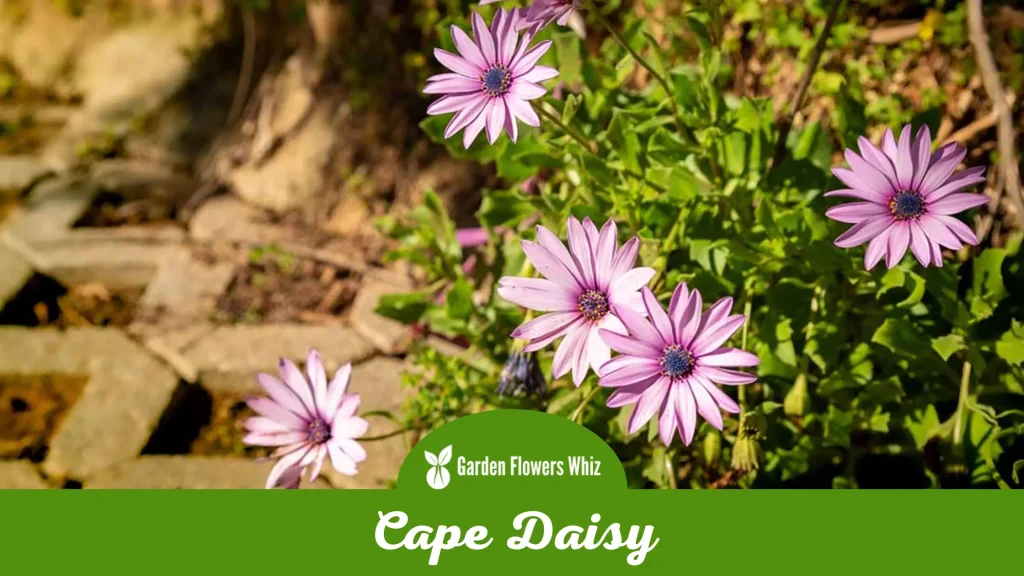
The lovely flowering plant known as Cape Daisy often referred to as Osteospermum, is indigenous to South Africa. Because of its gorgeous daisy-like blooms, this Asteraceae family plant is a favorite among gardeners.
Flowers from the Cape Daisy come in a variety of hues, including white, pink, yellow, orange, and purple. These flowers have narrow, slightly curled petals surrounding a bright yellow core.
Cape Daisy is a well-liked option for gardeners who wish to add color to their gardens because its blossoms bloom consistently throughout the growing season.
Cape Daisies prefer soil that drains well and is in full sun. Despite their drought tolerance, they need regular watering to keep their lovely blooms in bloom.
Depending on the climate, Cape Daisies can be grown as annuals or perennials. Cape Daisies are a well-liked choice for gardeners of all skill levels because they require little upkeep and are simple to care for. Also, they draw butterflies and other advantageous insects to the garden.
29. Canna Lily
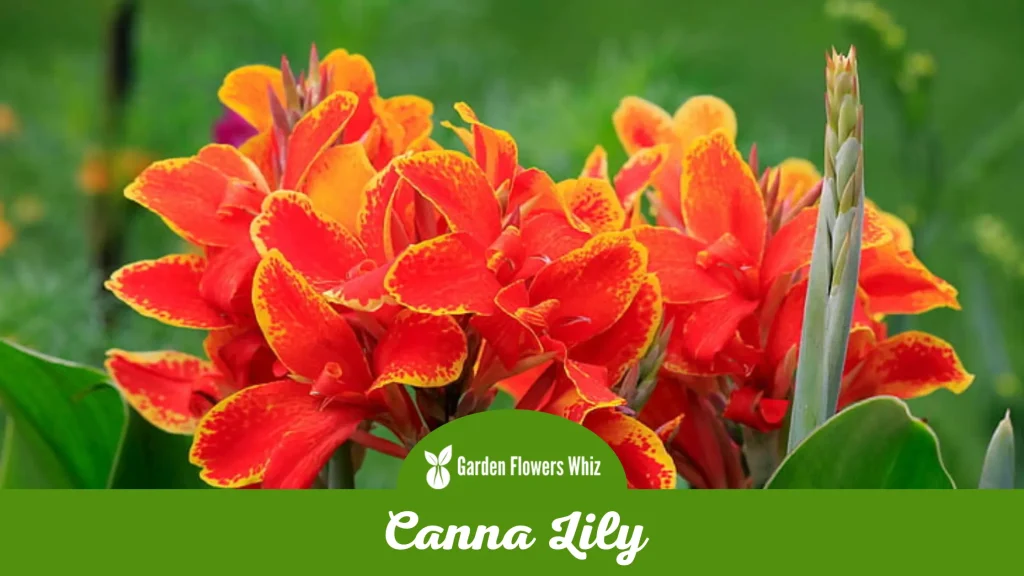
The Cannaceae family includes the lovely flowering plant known as the canna lily, sometimes referred to as Canna. This plant is popular for its huge, spectacular flowers that come in a variety of colors, including red, orange, pink, and yellow. It is native to tropical and subtropical areas of South and Central America.
It’s simple to grow and take care of canna lilies. They favor well-draining soil, full sun, or light shade. Despite being drought-tolerant, they require constant watering during the growing season to produce blooms that are healthy.
Canna lilies have huge, trumpet-shaped flowers that have three petals and three sepals. They begin to bloom in the late spring or early summer and keep doing so until the fall.
Canna lilies have wide, paddle-shaped leaves that contribute to the plant’s overall tropical appeal. Canna lilies are frequently used as container plants and in landscaping.
They are also used for their edible roots, which may be used in a variety of cuisines after being boiled or roasted.
30. Candytuft

The Brassicaceae family includes the lovely and delicate-looking Candytuft flower. This European and Western Asian native annual or perennial plant is a well-liked option for ground coverings, rock gardens, and garden borders.
Throughout the spring and summer, candytuft blooms, putting forth clusters of tiny, fragrant, white or pink flowers that are grouped in a flat-topped configuration.
The plant’s evergreen foliage grows into a mat of green leaves that contrasts well with the flower’s vibrant hues. The low-maintenance plant candytuft prefers full sun and soil that drains well.
Because of its drought tolerance, it can be planted in rock gardens, borders, or as a ground cover. Additionally appropriate for container planting is candytuft.
Purity, innocence, and faithfulness are just a few of the symbolic meanings associated with candytuft. To symbolize these values, it is frequently incorporated into floral bouquets and arrangements for weddings.
31. Canary Island Daisy
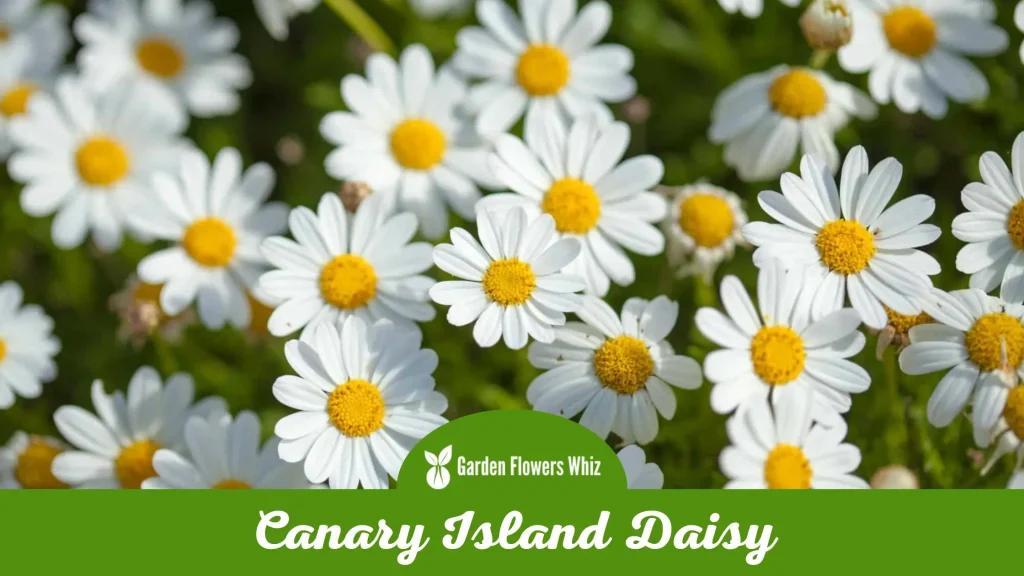
A lovely flowering plant native to the Canary Islands is the Canary Island Daisy, often called the Canary Island Marguerite.
This Asteraceae-family perennial plant is prized for its vivid and colourful blossoms. The Canary Island Daisy can reach a height of 1.5 feet and a width of two to three feet.
Large, daisy-like flowers in colours of yellow, pink, white, and orange are produced by the shrub. Although the blossoms normally appear in spring and summer, they may bloom all year long in temperate areas.
Caribbean Island Daisy is extremely simple to take care of and needs full light and soil that drains well. It can withstand drought and only needs light watering.
This plant is ideal for pots, rock gardens, and garden borders.
32. Canada Violet
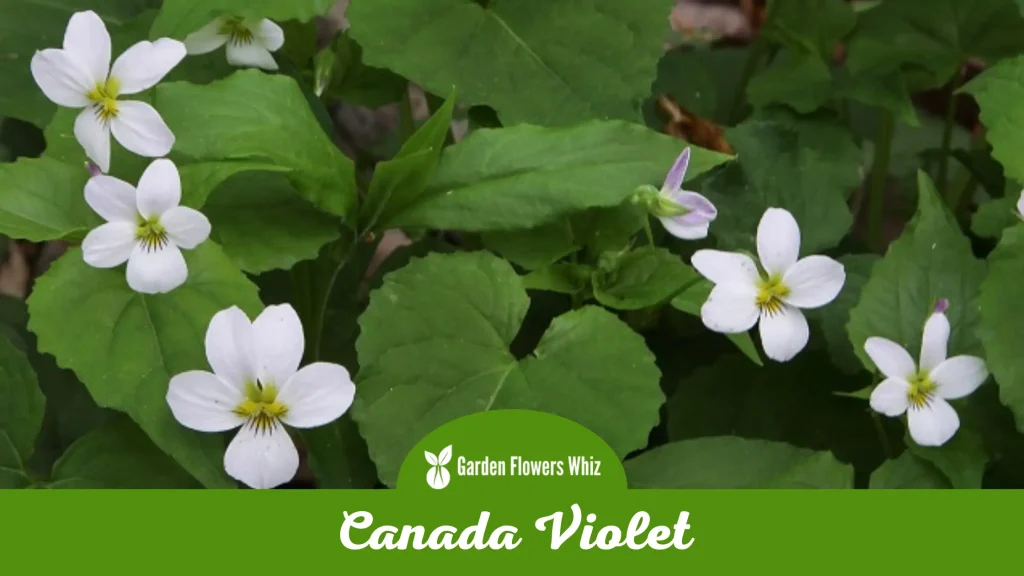
Canada Violet is a stunning perennial plant that is indigenous to North America. It is sometimes referred to as Yellow Violet or Common Yellow Violet. It grows in shady places like meadows, forests, and woodlands.
This wildflower has five-petaled, fragile, bright yellow blooms and heart-shaped, dark green leaves with serrated edges.
Canada Violet is a popular choice for gardeners who want to add colour to their landscape early in the season because it blooms in the early spring and keeps blooming through the summer.
The plant can handle some sun or whole shade, but likes wet, well-draining soil. Canada violet is a great choice for gardens that want to draw animals because it is also a favourite of pollinators including bees, butterflies, and hummingbirds.
A charming and practical addition to any garden or natural area is the Canada Violet.
33. Canadian Goldenrod

Solidago canadensis, often known as Canadian Goldenrod, is a native North American wildflower that is frequently seen in meadows and open spaces.
Late summer and early fall sees the flowering of its vivid yellow flowers, drawing a range of pollinators like bees, butterflies, and wasps.
The plant often forms clusters and has long, erect stems that can grow up to six feet tall. Despite its many advantages, Canadian Goldenrod is frequently wrongly held responsible for hay fever when, in reality, the real problem is ragweed that is fertilised by the wind.
Insects mostly spread goldenrod pollen since it is too heavy to be carried by the wind. Overall, Canadian Goldenrod is a robust, appealing plant that benefits pollinators and has long been used for medicinal purposes.
34. Campion
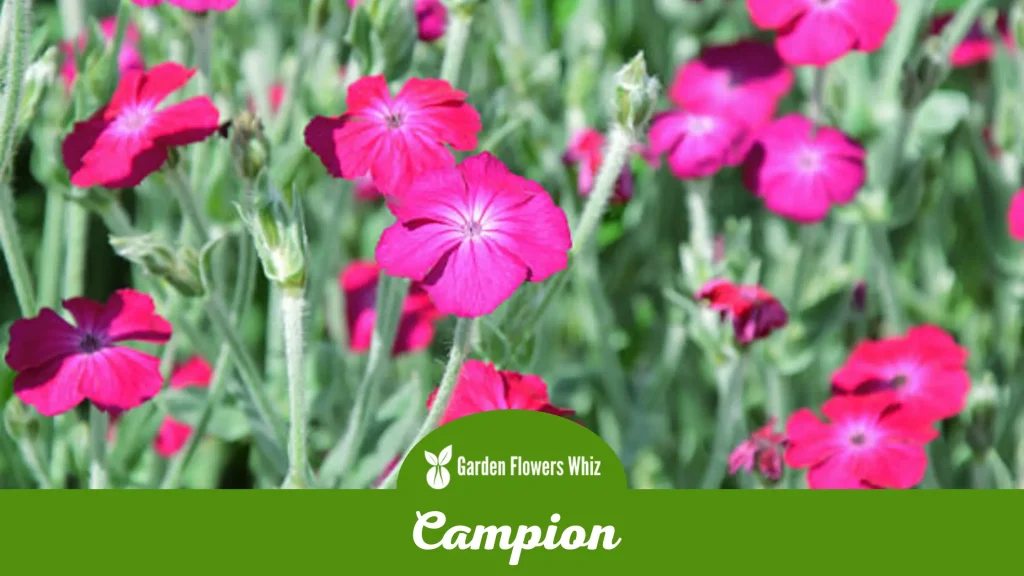
The Silene genus, which is a member of the Caryophyllaceae family, is home to the lovely, delicate flower known as the champion. This perennial grows naturally throughout Europe, and it is well-known for its lovely pink or white blossoms, which usually occur in late spring or early summer.
Flowers are a popular choice for garden borders, rock gardens, and woodland areas because they are quite spectacular and have a good scent.
The soil should be well-drained, and campion plants like full sun to partial shade. They are an excellent choice for beginning gardeners because they are reasonably simple to grow and care for.
Moreover, they can withstand a variety of soil types and drought situations. Little, star-shaped flowers with a diameter of about an inch are produced by the plant, which can reach heights of up to 2 feet.
35. Campanula latifolia
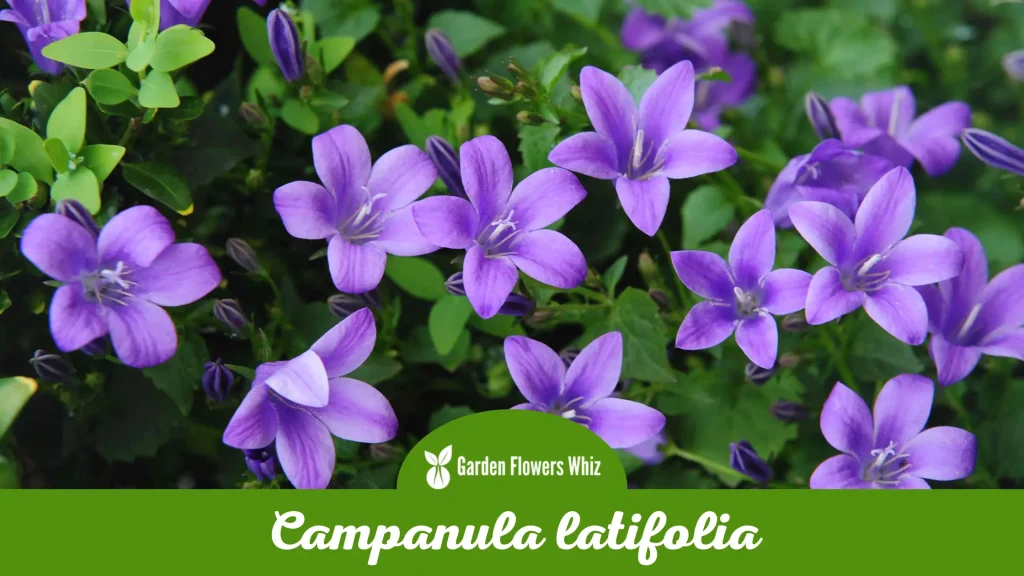
Campanula latifolia is a perennial blooming plant that is indigenous to Europe and western Asia. It is often referred to as the big bellflower or the large-flowered bellflower.
The huge, bell-shaped flowers of this magnificent flower, which occur in colors of blue, violet, and white, are highly coveted. The plant has dark green, serrated leaves that develop in a basal rosette and can reach a height of 1.5 meters.
Pollinators like bees and butterflies adore the Campanula latifolia flowers, which bloom from mid to late summer.
Low-maintenance Campanula latifolia likes well-draining soil and full sun over partial shade. Because of its lovely blossoms and ease of maintenance, it is frequently used in border plantings, rock gardens, and cottage gardens.
36. Camellia

East Asia is home to the flowering plant genus Camellia, which is a member of the Theaceae family. Its colorful and lovely flowers, glossy leaves, and capacity to flourish in a variety of soil types make it a well-liked ornamental plant.
Depending on the species and variation, camellias are evergreen shrubs or small trees that bloom in the late fall, winter, or early spring.
The most widespread variety, Camellia japonica, has enormous, rose-like blossoms that are colored pink, crimson, and white. Additional varieties include Camellia sasanqua, which blooms earlier in the season and has smaller flowers than Camellia sinensis, which is used to create tea.
Camellias can be cultivated in pots and are a common garden plant. They need soil that drains properly and some shade because too much straight sunshine can burn the leaves.
Also delicate to extremely hot and cold weather are camellias. In addition to being widely planted in China, Japan, and Korea, camellias are also grown in the south of the United States, particularly in California, where they are a popular landscape plant.
37. Calla Lily
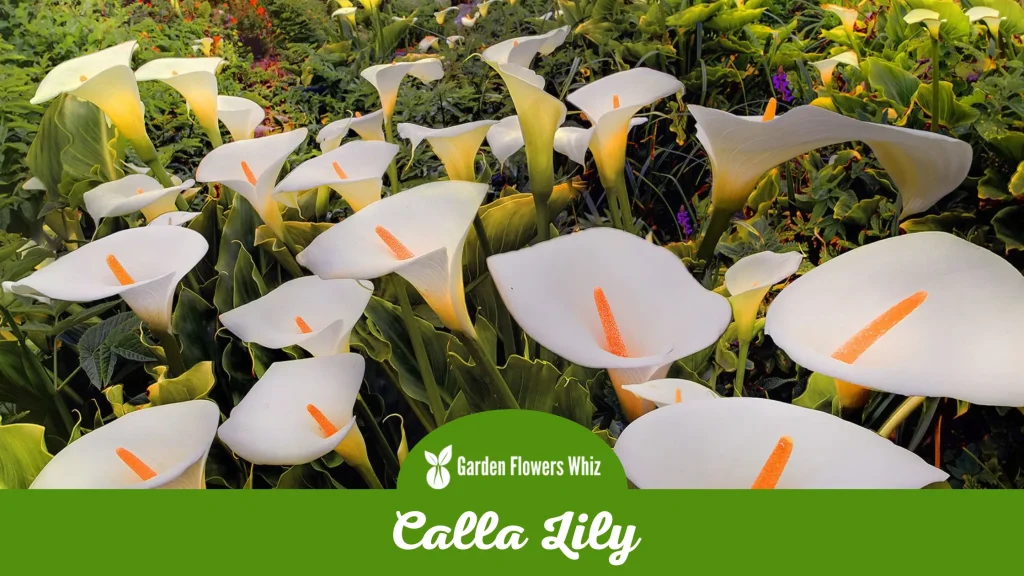
The Calla Lily is a distinctive and beautiful plant that is indigenous to Southern Africa. Its scientific name is Zantedeschia aethiopica. The plant is distinguished by its big, arrow-shaped leaves and trumpet-shaped blooms.
The colors of calla lilies range from white to pink to yellow to purple. The plant enjoys warm, humid conditions with well-draining soil and can reach heights of up to three feet.
Calla lilies have a long cultural history and have served many different functions over the years. They were used as burial objects in Ancient Egypt, and in Greek mythology, Hera’s milk is credited with creating the lily.
The calla lily has gained popularity as a bridal flower in recent times and is frequently connected to innocence and purity.
Despite being a lovely and well-liked decorative plant, calla lilies are poisonous if consumed, and coming into contact with their sap can irritate the skin.
Yet, because of their distinctive and gorgeous appearance, calla lilies continue to be a preferred selection for gardeners and floral enthusiasts.
38. California Poppy

Eschscholzia californica, sometimes referred to as the California Poppy, is a wildflower that is indigenous to western North America and northern Mexico.
The bright orange or yellow blossoms of this flower, which open in the morning and close in the evening, are its most distinctive feature. The California Poppy thrives in warm, dry areas and often reaches heights of 12 to 18 inches.
The official state flower of California and a longtime icon of the state is the California poppy.
The California poppy is a low-maintenance, drought-tolerant plant that is frequently utilised in gardens and landscaping today.
California poppies are quite simple to grow because they need full sun exposure and well-draining soil. Since these blooms self-seed, they can return to the same location year after year.
They are a well-liked option for rock gardens, wildflower meadows, and container gardens and can be planted in early spring or fall.
California poppy is a wonderful addition to any pollinator garden because it also draws bees, butterflies, and hummingbirds.
39. California Flannel Bush
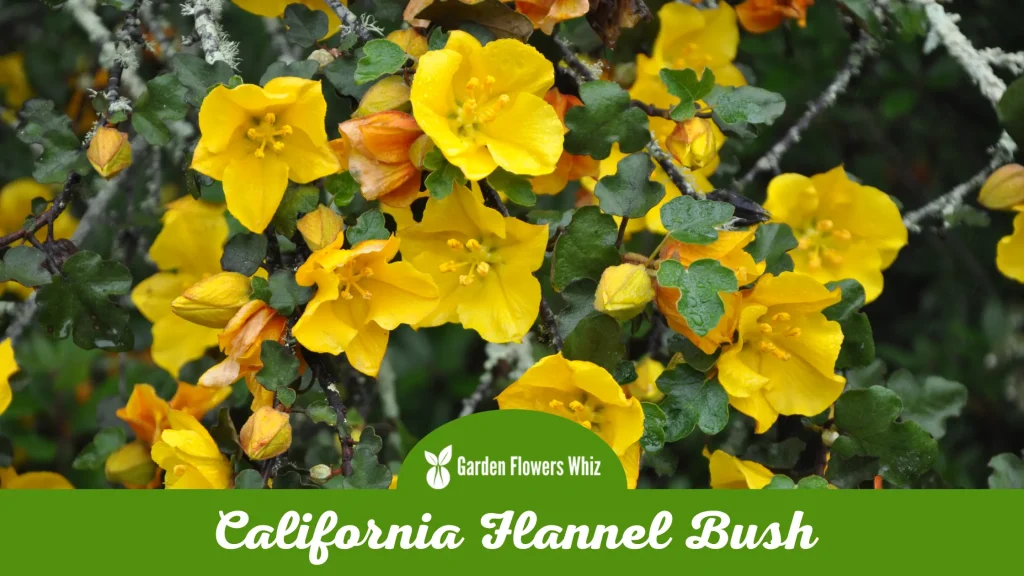
The Fremontia or Fremont’s flannel bush, commonly known as the California flannel bush, is a flowering shrub that is indigenous to California. It is a member of the Malvaceae family and is well-known for its eye-catching springtime yellow blossoms.
The five-petalled, huge flowers have a cup-like form. The leaves might be modest to enormous, and they are thick and velvety.
In California’s chaparral and coastal environments, the California flannel bush is a significant shrub. Due to its low water requirements and ability to grow up to 20 feet tall, it is a preferred choice for landscaping in places that are prone to drought.
Hardy and adaptable, the California flannel shrub can grow in a variety of soil conditions and is quite simple to grow. Yet, for it to flourish, the soil must drain well and be in full sun. Overwatering should be avoided because the plant is also prone to root rot.
40. Calendula Officinalis
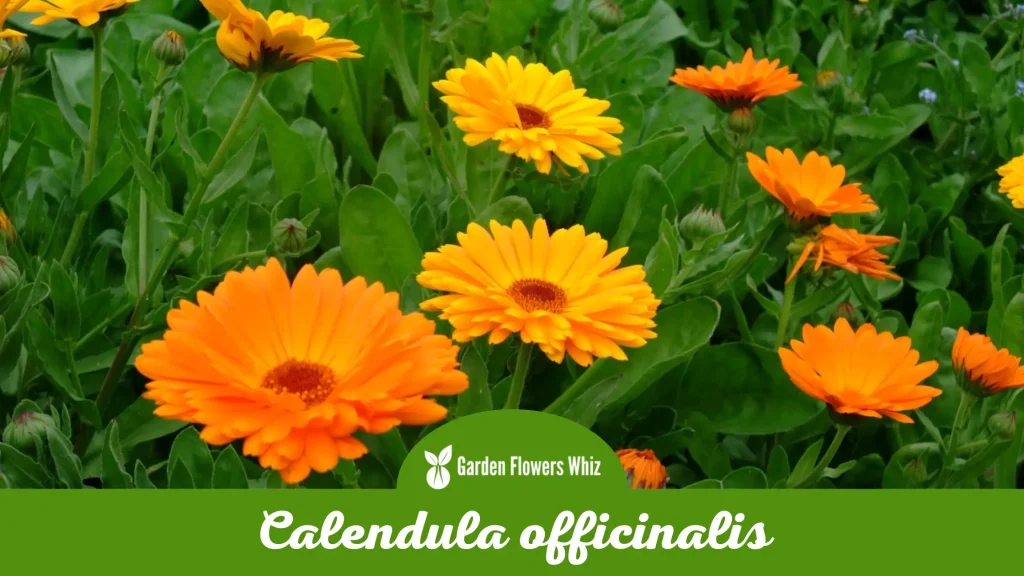
A flowering plant in the daisy family, calendula officinalis is also referred to as the pot marigold. It is extensively cultivated for its brilliant yellow or orange flowers and is a native of the Mediterranean region.
The plant has deeply lobed leaves and reaches a height of one to two feet. The blossoms are frequently utilized in both culinary and medicinal applications, and they have a peppery, acidic, and slightly bitter flavor.
Eczema, psoriasis, and acne are just a few of the skin diseases that can be treated with calendula. Minor burns, cuts, and bruises can also be treated with it to calm and mend them.
Due to its ability to repair skin damage and reduce inflammation, calendula is frequently utilized in skincare and cosmetic products.
It is frequently present in lotions, creams, and ointments for skin that is dry or irritated. Calendula is a low-maintenance annual that can be used as a bright accent to flower beds, borders, and container gardens. It blooms from late spring to early fall.
In Summary
Gardeners have a wide variety of vibrant flowers that start with C. Every flower, from the delicate columbine to the robust California poppy, has its own distinct beauty and traits.
Yet, C-letter flowers can also have significant ecological and cultural significance in addition to their aesthetic worth. For instance, the Canadian Goldenrod serves as an important source of food for bees and other pollinators, while the Cranesbill Geranium has a long history of use in both medicine and cuisine.

Stacey Hernandez is a seasoned botanist with over 16 years of experience in the field. Her passion for plants and their intricate workings began at a young age, and she has since devoted her life to studying and understanding them.
Stacey’s expertise extends to a wide range of plant species, from delicate flowers to towering trees. As the founder of Garden Flowers Whiz, Stacey has created a platform for plant enthusiasts to seek guidance and advice.
Her website is a go-to resource for those seeking answers to their gardening dilemmas, whether it’s how to care for a particular plant or which species to choose for a specific climate.
